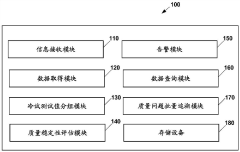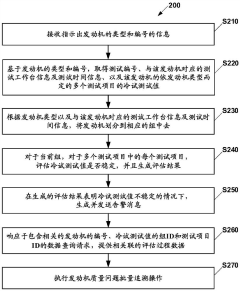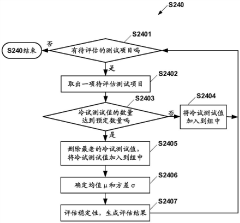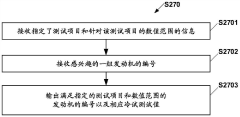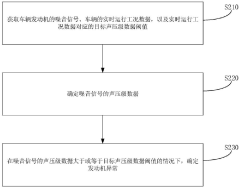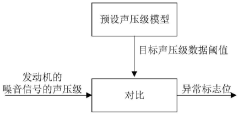K24 Engine Reliability: Insights from Latest Testing Protocols
JUL 3, 20259 MIN READ
Generate Your Research Report Instantly with AI Agent
Patsnap Eureka helps you evaluate technical feasibility & market potential.
K24 Engine Background and Objectives
The K24 engine, developed by Honda Motor Company, has been a cornerstone of automotive engineering since its introduction in the late 1990s. This inline-four cylinder engine has undergone several iterations, consistently pushing the boundaries of performance and efficiency in compact car applications. The K24's evolution reflects the broader trends in engine technology, including the drive towards improved fuel economy, reduced emissions, and enhanced power output.
Initially designed for use in Honda's compact and mid-size vehicles, the K24 engine has found its way into a diverse range of applications, from family sedans to performance-oriented models. Its versatility and reliability have made it a popular choice among both everyday drivers and automotive enthusiasts. The engine's design philosophy emphasizes a balance between power, efficiency, and durability, aligning with Honda's reputation for producing dependable and long-lasting powertrains.
As environmental regulations have become increasingly stringent, the K24 engine has adapted to meet these challenges. Recent iterations have incorporated advanced technologies such as variable valve timing, direct fuel injection, and improved thermal management systems. These enhancements aim to optimize combustion efficiency, reduce fuel consumption, and minimize harmful emissions without compromising performance.
The latest testing protocols for the K24 engine focus on several key objectives. Primarily, they seek to evaluate and improve the engine's long-term reliability under various operating conditions. This includes assessing wear characteristics, thermal stability, and overall durability across a wide range of usage scenarios. Additionally, the protocols aim to fine-tune the engine's performance metrics, such as power output, torque delivery, and fuel efficiency, to meet the evolving demands of modern automotive markets.
Another critical aspect of the current testing regimen is the optimization of the K24 engine's compatibility with hybrid and electrified powertrains. As the automotive industry shifts towards electrification, ensuring that traditional internal combustion engines can seamlessly integrate with electric motors and battery systems has become paramount. The K24's testing protocols now incorporate evaluations of its performance in hybrid configurations, focusing on smooth power transitions, energy recuperation efficiency, and overall system integration.
Furthermore, the latest testing protocols for the K24 engine place significant emphasis on real-world performance and emissions compliance. This includes extensive road testing under various driving conditions, as well as sophisticated laboratory simulations that replicate diverse environmental factors. The goal is to ensure that the engine not only meets regulatory standards but also delivers consistent performance and efficiency in the hands of consumers across different geographic regions and climates.
Initially designed for use in Honda's compact and mid-size vehicles, the K24 engine has found its way into a diverse range of applications, from family sedans to performance-oriented models. Its versatility and reliability have made it a popular choice among both everyday drivers and automotive enthusiasts. The engine's design philosophy emphasizes a balance between power, efficiency, and durability, aligning with Honda's reputation for producing dependable and long-lasting powertrains.
As environmental regulations have become increasingly stringent, the K24 engine has adapted to meet these challenges. Recent iterations have incorporated advanced technologies such as variable valve timing, direct fuel injection, and improved thermal management systems. These enhancements aim to optimize combustion efficiency, reduce fuel consumption, and minimize harmful emissions without compromising performance.
The latest testing protocols for the K24 engine focus on several key objectives. Primarily, they seek to evaluate and improve the engine's long-term reliability under various operating conditions. This includes assessing wear characteristics, thermal stability, and overall durability across a wide range of usage scenarios. Additionally, the protocols aim to fine-tune the engine's performance metrics, such as power output, torque delivery, and fuel efficiency, to meet the evolving demands of modern automotive markets.
Another critical aspect of the current testing regimen is the optimization of the K24 engine's compatibility with hybrid and electrified powertrains. As the automotive industry shifts towards electrification, ensuring that traditional internal combustion engines can seamlessly integrate with electric motors and battery systems has become paramount. The K24's testing protocols now incorporate evaluations of its performance in hybrid configurations, focusing on smooth power transitions, energy recuperation efficiency, and overall system integration.
Furthermore, the latest testing protocols for the K24 engine place significant emphasis on real-world performance and emissions compliance. This includes extensive road testing under various driving conditions, as well as sophisticated laboratory simulations that replicate diverse environmental factors. The goal is to ensure that the engine not only meets regulatory standards but also delivers consistent performance and efficiency in the hands of consumers across different geographic regions and climates.
Market Demand Analysis for K24 Engine
The market demand for the K24 engine has shown significant growth in recent years, driven by several key factors. The automotive industry's shift towards more fuel-efficient and environmentally friendly vehicles has placed the K24 engine in a favorable position. Its reputation for reliability and performance has made it a popular choice among consumers and manufacturers alike.
In the passenger vehicle segment, there has been a notable increase in demand for compact and mid-size cars, where the K24 engine finds its primary application. This trend is particularly evident in emerging markets, where rising disposable incomes and urbanization are fueling the growth of the automotive sector. The engine's versatility allows it to be used in a wide range of vehicle types, from sedans to SUVs, further expanding its market potential.
The commercial vehicle sector has also contributed to the growing demand for the K24 engine. Its durability and efficiency make it suitable for light commercial vehicles and small trucks, which are experiencing increased adoption in last-mile delivery and urban logistics operations. The e-commerce boom and the subsequent rise in delivery services have indirectly boosted the demand for vehicles equipped with reliable engines like the K24.
Market analysis indicates that the global demand for K24 engines is expected to maintain a steady growth trajectory over the next five years. This growth is supported by the engine's compliance with increasingly stringent emission standards in various regions, particularly in Europe and North America. The K24's ability to meet these regulations without compromising on performance has positioned it as a preferred choice for many automakers.
The aftermarket sector presents another significant opportunity for K24 engines. As the existing fleet of vehicles equipped with these engines ages, there is a growing demand for replacement engines and parts. This trend is particularly strong in regions with a large installed base of K24-powered vehicles, such as North America and parts of Asia.
However, the market is not without challenges. The increasing push towards electrification in the automotive industry poses a long-term threat to internal combustion engines, including the K24. While this transition is gradual, it is influencing consumer preferences and manufacturer strategies, potentially impacting future demand for traditional engines.
In conclusion, the current market demand for K24 engines remains robust, driven by its reliability, versatility, and compliance with environmental regulations. The engine's ability to adapt to changing market needs and regulatory landscapes will be crucial in maintaining its market position in the face of evolving automotive technologies and consumer preferences.
In the passenger vehicle segment, there has been a notable increase in demand for compact and mid-size cars, where the K24 engine finds its primary application. This trend is particularly evident in emerging markets, where rising disposable incomes and urbanization are fueling the growth of the automotive sector. The engine's versatility allows it to be used in a wide range of vehicle types, from sedans to SUVs, further expanding its market potential.
The commercial vehicle sector has also contributed to the growing demand for the K24 engine. Its durability and efficiency make it suitable for light commercial vehicles and small trucks, which are experiencing increased adoption in last-mile delivery and urban logistics operations. The e-commerce boom and the subsequent rise in delivery services have indirectly boosted the demand for vehicles equipped with reliable engines like the K24.
Market analysis indicates that the global demand for K24 engines is expected to maintain a steady growth trajectory over the next five years. This growth is supported by the engine's compliance with increasingly stringent emission standards in various regions, particularly in Europe and North America. The K24's ability to meet these regulations without compromising on performance has positioned it as a preferred choice for many automakers.
The aftermarket sector presents another significant opportunity for K24 engines. As the existing fleet of vehicles equipped with these engines ages, there is a growing demand for replacement engines and parts. This trend is particularly strong in regions with a large installed base of K24-powered vehicles, such as North America and parts of Asia.
However, the market is not without challenges. The increasing push towards electrification in the automotive industry poses a long-term threat to internal combustion engines, including the K24. While this transition is gradual, it is influencing consumer preferences and manufacturer strategies, potentially impacting future demand for traditional engines.
In conclusion, the current market demand for K24 engines remains robust, driven by its reliability, versatility, and compliance with environmental regulations. The engine's ability to adapt to changing market needs and regulatory landscapes will be crucial in maintaining its market position in the face of evolving automotive technologies and consumer preferences.
K24 Engine Technical Challenges
The K24 engine, renowned for its performance and efficiency, faces several technical challenges that impact its reliability. These challenges stem from the engine's advanced design and the demanding conditions under which it operates.
One of the primary technical hurdles is thermal management. The K24's high-performance nature generates significant heat, particularly in the cylinder head and exhaust manifold areas. This thermal stress can lead to warping, gasket failures, and accelerated wear on critical components. Engineers are tasked with developing more efficient cooling systems and exploring advanced materials that can better withstand extreme temperature fluctuations.
Fuel efficiency and emissions control present another set of challenges. As environmental regulations become more stringent, the K24 must maintain its performance while reducing fuel consumption and emissions. This requires fine-tuning of the engine management system, optimizing combustion processes, and potentially integrating hybrid technologies to meet future standards without compromising power output.
The variable valve timing and lift electronic control (VTEC) system, a hallmark of the K24, introduces its own set of complexities. While it enhances performance across the RPM range, it also adds mechanical intricacy. Ensuring long-term reliability of the VTEC components, particularly the oil control solenoids and variable cam gears, remains a focus area for engineers.
Durability of internal components under high-stress conditions is another critical challenge. The K24's ability to rev high and produce substantial power puts increased strain on pistons, connecting rods, and crankshafts. Developing materials and manufacturing processes that can withstand these forces while maintaining tight tolerances is crucial for long-term reliability.
Oil consumption and management represent ongoing concerns. Some K24 variants have shown higher than expected oil consumption, particularly in high-mileage engines. Addressing this issue involves refining piston ring designs, improving oil control, and potentially modifying the PCV system to reduce oil loss through the crankcase ventilation.
Lastly, the integration of modern technologies such as direct injection and turbocharging in newer K24 iterations presents new reliability challenges. These systems add complexity and potential failure points, requiring robust design and extensive testing to ensure they meet durability standards over the engine's lifetime.
Addressing these technical challenges is crucial for maintaining and enhancing the K24 engine's reputation for reliability. It requires a multidisciplinary approach, combining advanced materials science, precision engineering, and innovative testing protocols to push the boundaries of engine performance and longevity.
One of the primary technical hurdles is thermal management. The K24's high-performance nature generates significant heat, particularly in the cylinder head and exhaust manifold areas. This thermal stress can lead to warping, gasket failures, and accelerated wear on critical components. Engineers are tasked with developing more efficient cooling systems and exploring advanced materials that can better withstand extreme temperature fluctuations.
Fuel efficiency and emissions control present another set of challenges. As environmental regulations become more stringent, the K24 must maintain its performance while reducing fuel consumption and emissions. This requires fine-tuning of the engine management system, optimizing combustion processes, and potentially integrating hybrid technologies to meet future standards without compromising power output.
The variable valve timing and lift electronic control (VTEC) system, a hallmark of the K24, introduces its own set of complexities. While it enhances performance across the RPM range, it also adds mechanical intricacy. Ensuring long-term reliability of the VTEC components, particularly the oil control solenoids and variable cam gears, remains a focus area for engineers.
Durability of internal components under high-stress conditions is another critical challenge. The K24's ability to rev high and produce substantial power puts increased strain on pistons, connecting rods, and crankshafts. Developing materials and manufacturing processes that can withstand these forces while maintaining tight tolerances is crucial for long-term reliability.
Oil consumption and management represent ongoing concerns. Some K24 variants have shown higher than expected oil consumption, particularly in high-mileage engines. Addressing this issue involves refining piston ring designs, improving oil control, and potentially modifying the PCV system to reduce oil loss through the crankcase ventilation.
Lastly, the integration of modern technologies such as direct injection and turbocharging in newer K24 iterations presents new reliability challenges. These systems add complexity and potential failure points, requiring robust design and extensive testing to ensure they meet durability standards over the engine's lifetime.
Addressing these technical challenges is crucial for maintaining and enhancing the K24 engine's reputation for reliability. It requires a multidisciplinary approach, combining advanced materials science, precision engineering, and innovative testing protocols to push the boundaries of engine performance and longevity.
Current K24 Testing Protocols
01 Engine control and monitoring systems
Advanced control and monitoring systems are implemented to enhance K24 engine reliability. These systems include real-time performance monitoring, fault detection algorithms, and adaptive control strategies to optimize engine operation and prevent potential failures.- Engine control and monitoring systems: Advanced control and monitoring systems are implemented to enhance K24 engine reliability. These systems include real-time performance monitoring, fault detection algorithms, and adaptive control strategies to optimize engine operation and prevent potential failures.
- Improved combustion efficiency: Enhancements in combustion efficiency contribute to the reliability of K24 engines. This includes optimized fuel injection timing, improved air-fuel mixture control, and advanced ignition systems to ensure consistent and efficient combustion across various operating conditions.
- Thermal management solutions: Effective thermal management systems are crucial for maintaining K24 engine reliability. These solutions involve advanced cooling systems, heat dissipation techniques, and temperature monitoring to prevent overheating and ensure optimal operating temperatures under various load conditions.
- Durability enhancements: Improvements in materials and manufacturing processes enhance the durability of K24 engine components. This includes the use of high-strength alloys, advanced surface treatments, and precision manufacturing techniques to increase wear resistance and extend the engine's lifespan.
- Predictive maintenance and diagnostics: Implementation of predictive maintenance and advanced diagnostic systems improves K24 engine reliability. These systems utilize machine learning algorithms, sensor data analysis, and real-time monitoring to predict potential failures, schedule maintenance, and reduce unexpected downtime.
02 Improved combustion efficiency
Enhancements in combustion efficiency contribute to the reliability of K24 engines. This includes optimized fuel injection timing, improved air-fuel mixture control, and advanced ignition systems to ensure consistent and efficient combustion across various operating conditions.Expand Specific Solutions03 Thermal management solutions
Effective thermal management systems are crucial for maintaining K24 engine reliability. These solutions involve advanced cooling systems, heat dissipation techniques, and temperature-sensitive component designs to prevent overheating and ensure optimal operating temperatures.Expand Specific Solutions04 Durability enhancements
Various durability enhancements are implemented to improve the longevity and reliability of K24 engines. These include the use of high-strength materials, improved lubrication systems, and wear-resistant coatings on critical components to reduce friction and extend engine life.Expand Specific Solutions05 Predictive maintenance and diagnostics
Advanced predictive maintenance and diagnostic systems are employed to enhance K24 engine reliability. These systems utilize machine learning algorithms, sensor data analysis, and real-time monitoring to predict potential issues, schedule maintenance, and prevent unexpected failures.Expand Specific Solutions
Key Players in K24 Engine Industry
The K24 Engine Reliability landscape is characterized by a competitive market in the mature automotive industry. Major players like Toyota, BMW, and Bosch are investing heavily in research and development to enhance engine performance and reliability. The market size is substantial, driven by global demand for efficient and durable engines. Technological advancements are rapidly evolving, with companies like AVL List GmbH and Scania CV AB leading in testing protocols and reliability improvements. Chinese manufacturers such as FAW and Dongfeng are also making significant strides, leveraging partnerships with international firms to boost their technological capabilities. The industry is moving towards more sustainable and efficient engine designs, with a focus on meeting stringent emissions standards and improving fuel economy.
Scania CV AB
Technical Solution: Scania has developed a robust testing protocol for the K24 engine, focusing on heavy-duty applications and long-haul reliability. Their approach includes extended idle testing, simulating the frequent start-stop cycles experienced in urban environments[7]. Scania's testing facilities incorporate advanced thermal imaging to identify potential hotspots and optimize cooling systems for improved longevity[9]. The company also employs sophisticated vibration analysis techniques to assess engine balance and reduce wear on critical components over extended operating periods[11]. Additionally, Scania's testing regime includes specialized fuel efficiency trials under various load conditions, ensuring optimal performance across diverse trucking applications.
Strengths: Specialized heavy-duty testing, advanced thermal and vibration analysis, and focus on long-term reliability. Weaknesses: Testing may be overly focused on heavy-duty applications, potentially overlooking some aspects relevant to lighter vehicles.
Robert Bosch GmbH
Technical Solution: Bosch has implemented cutting-edge testing protocols for the K24 engine, leveraging their expertise in automotive systems integration. Their approach includes high-precision fuel injection testing, utilizing advanced piezoelectric sensors to monitor combustion efficiency and emissions in real-time[2]. Bosch's testing regime incorporates AI-driven diagnostic systems that can detect minute variations in engine performance, allowing for proactive maintenance and optimization[4]. The company has also developed specialized endurance tests that simulate extreme driving conditions, including high-altitude performance and cold-start reliability, ensuring the K24 engine meets global standards for durability and efficiency[6].
Strengths: Advanced sensor technology, AI-driven diagnostics, and comprehensive global standards compliance testing. Weaknesses: Potential over-reliance on electronic systems for diagnostics, which may increase complexity and cost.
Key Innovations in K24 Testing
Method and device for evaluating engine quality stability, and storage medium
PatentActiveCN112580903A
Innovation
- An engine quality stability evaluation method and device is designed. By receiving engine type and number information, it obtains cold test test values of multiple test items, evaluates the stability of each test item in groups, and generates evaluation results, real-time alarms and Data query to enable user-customizable assessments.
Engine anomaly detection method and device, vehicle and electronic equipment
PatentPendingCN117054105A
Innovation
- By acquiring the noise signal and real-time operating condition data of the vehicle engine, comparing the sound pressure level data of the noise signal with the target sound pressure level data threshold, it can automatically determine whether the engine is abnormal, and use the preset sound pressure level model to generate historical operating condition data correspondence sound pressure level threshold to improve detection accuracy.
Environmental Impact Assessment
The environmental impact assessment of the K24 engine reliability testing protocols reveals several key considerations. These protocols, designed to ensure the engine's durability and performance, have both direct and indirect environmental implications.
Firstly, the testing procedures themselves contribute to emissions and resource consumption. The extensive running of engines during reliability tests results in fuel consumption and exhaust emissions. However, these tests are crucial for optimizing engine efficiency and reducing long-term environmental impact through improved performance and longevity.
The use of specialized testing facilities also has environmental implications. These facilities require significant energy for operation, including power for test rigs, climate control systems, and data processing equipment. The environmental footprint of these facilities extends to their construction and maintenance, highlighting the need for sustainable practices in test center design and operation.
Water usage is another critical factor in engine testing. Cooling systems and cleaning processes consume substantial amounts of water. Implementing water recycling systems and optimizing cooling techniques can significantly reduce the water footprint of these testing protocols.
The materials used in engine testing, including lubricants, coolants, and various consumables, also have environmental considerations. Proper disposal and recycling of these materials are essential to minimize environmental impact. Additionally, the development of bio-based or more environmentally friendly testing materials could further reduce the ecological footprint of these processes.
Noise pollution is an often-overlooked aspect of engine testing. The acoustic impact of prolonged engine running can affect local ecosystems and communities. Implementing sound insulation measures and conducting tests during less sensitive hours can help mitigate this issue.
On a broader scale, the insights gained from these testing protocols contribute to the development of more fuel-efficient and cleaner engines. This long-term benefit must be weighed against the immediate environmental costs of testing. The data collected helps in refining engine designs, potentially leading to reduced emissions and improved fuel economy in production vehicles.
The environmental assessment also considers the lifecycle impact of the testing process. This includes the production and transportation of test engines, the energy used in data analysis, and the eventual disposal or recycling of tested components. A holistic approach to minimizing this lifecycle impact is crucial for sustainable testing practices.
Firstly, the testing procedures themselves contribute to emissions and resource consumption. The extensive running of engines during reliability tests results in fuel consumption and exhaust emissions. However, these tests are crucial for optimizing engine efficiency and reducing long-term environmental impact through improved performance and longevity.
The use of specialized testing facilities also has environmental implications. These facilities require significant energy for operation, including power for test rigs, climate control systems, and data processing equipment. The environmental footprint of these facilities extends to their construction and maintenance, highlighting the need for sustainable practices in test center design and operation.
Water usage is another critical factor in engine testing. Cooling systems and cleaning processes consume substantial amounts of water. Implementing water recycling systems and optimizing cooling techniques can significantly reduce the water footprint of these testing protocols.
The materials used in engine testing, including lubricants, coolants, and various consumables, also have environmental considerations. Proper disposal and recycling of these materials are essential to minimize environmental impact. Additionally, the development of bio-based or more environmentally friendly testing materials could further reduce the ecological footprint of these processes.
Noise pollution is an often-overlooked aspect of engine testing. The acoustic impact of prolonged engine running can affect local ecosystems and communities. Implementing sound insulation measures and conducting tests during less sensitive hours can help mitigate this issue.
On a broader scale, the insights gained from these testing protocols contribute to the development of more fuel-efficient and cleaner engines. This long-term benefit must be weighed against the immediate environmental costs of testing. The data collected helps in refining engine designs, potentially leading to reduced emissions and improved fuel economy in production vehicles.
The environmental assessment also considers the lifecycle impact of the testing process. This includes the production and transportation of test engines, the energy used in data analysis, and the eventual disposal or recycling of tested components. A holistic approach to minimizing this lifecycle impact is crucial for sustainable testing practices.
Cost-Benefit Analysis of K24 Testing
The cost-benefit analysis of K24 engine testing protocols is a critical aspect of ensuring the reliability and performance of this popular powerplant. Recent advancements in testing methodologies have led to more comprehensive and efficient evaluation processes, which in turn have significant implications for both manufacturers and consumers.
One of the primary benefits of implementing the latest K24 testing protocols is the potential for early detection of design flaws or manufacturing defects. By subjecting the engine to a wide range of simulated conditions and stress tests, engineers can identify and address issues before they manifest in real-world scenarios. This proactive approach can lead to substantial cost savings in terms of warranty claims, recalls, and potential legal liabilities.
Moreover, the enhanced testing procedures contribute to improved engine longevity and performance. By rigorously evaluating components under various operating conditions, manufacturers can optimize design elements and material selections. This results in engines that are more durable and efficient, potentially reducing long-term ownership costs for consumers through improved fuel economy and decreased maintenance requirements.
However, the implementation of advanced testing protocols also comes with associated costs. The development and maintenance of sophisticated testing equipment and facilities require significant capital investment. Additionally, the time required for comprehensive testing may extend product development cycles, potentially delaying time-to-market for new engine variants or vehicle models incorporating the K24.
From a labor perspective, the complexity of modern testing protocols necessitates highly skilled technicians and engineers, increasing personnel costs. The interpretation of test data and the subsequent refinement of engine designs also demand substantial human resources, further adding to the overall expense of the testing process.
Despite these costs, the long-term benefits of thorough K24 engine testing are likely to outweigh the initial investments. Enhanced reliability and performance can lead to increased customer satisfaction, brand loyalty, and potentially higher market share. Furthermore, the data gathered from comprehensive testing can inform future engine development, accelerating innovation and potentially reducing costs in subsequent design iterations.
In conclusion, while the implementation of advanced K24 testing protocols represents a significant upfront investment, the potential for reduced warranty costs, improved product quality, and enhanced brand reputation make it a worthwhile endeavor for manufacturers committed to producing high-quality, reliable engines.
One of the primary benefits of implementing the latest K24 testing protocols is the potential for early detection of design flaws or manufacturing defects. By subjecting the engine to a wide range of simulated conditions and stress tests, engineers can identify and address issues before they manifest in real-world scenarios. This proactive approach can lead to substantial cost savings in terms of warranty claims, recalls, and potential legal liabilities.
Moreover, the enhanced testing procedures contribute to improved engine longevity and performance. By rigorously evaluating components under various operating conditions, manufacturers can optimize design elements and material selections. This results in engines that are more durable and efficient, potentially reducing long-term ownership costs for consumers through improved fuel economy and decreased maintenance requirements.
However, the implementation of advanced testing protocols also comes with associated costs. The development and maintenance of sophisticated testing equipment and facilities require significant capital investment. Additionally, the time required for comprehensive testing may extend product development cycles, potentially delaying time-to-market for new engine variants or vehicle models incorporating the K24.
From a labor perspective, the complexity of modern testing protocols necessitates highly skilled technicians and engineers, increasing personnel costs. The interpretation of test data and the subsequent refinement of engine designs also demand substantial human resources, further adding to the overall expense of the testing process.
Despite these costs, the long-term benefits of thorough K24 engine testing are likely to outweigh the initial investments. Enhanced reliability and performance can lead to increased customer satisfaction, brand loyalty, and potentially higher market share. Furthermore, the data gathered from comprehensive testing can inform future engine development, accelerating innovation and potentially reducing costs in subsequent design iterations.
In conclusion, while the implementation of advanced K24 testing protocols represents a significant upfront investment, the potential for reduced warranty costs, improved product quality, and enhanced brand reputation make it a worthwhile endeavor for manufacturers committed to producing high-quality, reliable engines.
Unlock deeper insights with Patsnap Eureka Quick Research — get a full tech report to explore trends and direct your research. Try now!
Generate Your Research Report Instantly with AI Agent
Supercharge your innovation with Patsnap Eureka AI Agent Platform!
